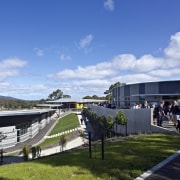Learned behaviour
An innovative school by Hassell with Jaws Architects
The 21st century may be only a decade old but the technological advances made since Y2K days, when we feared a simple glitch would propel us back to the Dark Ages, are staggering.
More than ever we live in a diverse, increasingly globalised and multimedia-saturated world that few of us would have thought possible a mere 10 years ago. Imagine then, what the world could be like in 50 years' time, when our high-schoolers retire and we move through the second half of the century.
It has always been the role of education to prepare students for the future, but up until fairly recently it was a future based on lessons learned from the past. Now, so much of what we're learning is happening in real time, and our educational systems and schools need to reflect that, says Adriano Denni, senior associate with Hassell.
"The Kingston High School project near Hobart is the result of a paradigm shift in educational thinking that is occurring around the world one that combines architecture and pedagogy into a comprehensive learning experience.
"The design reflects the multidisciplined approach the Department of Education (DoE) was looking to achieve. It responds to the site, incorporates environmentally sustainable initiatives, facilitates learning, fosters community participation and features in-built future proofing, technological and physical."
However, it is at the face-value level that most of us would notice a change from traditional ideas of school design.
"Our team employed the shape of an abstracted mathematical sine wave form," says Denni. "The shape represents the path of learning, and the resulting arrangement of spaces provides a physical connection, which encourages communication between students, teachers and the community."
There is also a connection between the built and natural environments, which has a physical and sustainable side, as well as a more intangible one that speaks to fostering community spirit, says fellow senior associate Matt Mackay.
"The architectural response also had to take into account the unique characteristics of the site, including a 20m fall across the area that underwent development. The staggered nature of the design meant we were able to maximise the aspect to northern light and passive solar energy, while the low-profile nature of the development meant the view from neighbouring residential properties down to the Derwent River was maintained."
The directive to produce the most sustainable facility was a key driver of the project, says Mackay.
"The DoE, when they looked at this project, said not only do we want to do something with this project that is quite unique and contemporary both architecturally and in terms of the learning programme, but we also want to strive to achieve one of the most sustainable built forms we can deliver within the budget.
"So they really established a set of high-reaching goals for the project, which was nice for us to have to respond to, as many schools we've designed have budget constraints that prohibit this level of sustainable design thinking being realised."
Sustainable initiatives include Australia's first green roof system on a school. The system is designed to provide improved thermal and acoustic insulation, mitigate stormwater run-off during heavy rains and to filter greywater for use for irrigation.As well as being a first for a school, the green roof comprises plants endemic to the Hobart region, augmenting indigenous planting on the site.
Other environmentally friendly initiatives included an obligation to minimise the carbon footprint of the project at every stage of its life cycle. One of the long-term considerations is the co-location of shared facilities, says Denni.
"Kingborough Council was an important stakeholder in the project as well, providing funds to expand the school for use by the wider community. Located adjacent to the school grounds, the Kingborough Sports Stadium plays host to around 200 school and community teams each week. Coupled with the school's auditorium, which is available under a booking system for a variety of events, this establishes a real sense of community ownership and involvement for the school.
"A peripheral benefit of this extension is that the community becomes actively involved in the security and safety of the school," says Denni. "With the facilities being used on a round-the-clock basis there is an inherent element of passive surveillance."
A strong buy-in from a diverse range of community stakeholders and users, combined with the financial investment, meant ensuring the school can adapt to changing needs was also paramount.
"Future-proofing was always a consideration in the masterplanning of the project. To the east of the site there is a parcel of land that is owned by the council, which is big enough to build two of the classroom clusters on," says Denni.
"And obviously, in terms of the infrastructure, services and IT structure, those systems have been designed to incorporate future growth."
"Not only that, but when we were developing the water strategy for the campus, it was in the midst of the drought we were having in Melbourne," says Mackay. "At the time this had very little impact on the weather in Tasmania, but the potential for future adverse weather events has been taken into account. As well as the greywater system and stormwater collection, provision has been made to tap into the collection potential of the sports stadium. If necessary, the whole campus can effectively be removed from mains water supply."
"Kingston sets a new benchmark for excellence in sustainability and education," says Denni. "Its design is visionary, and more importantly, engaging. Anecdotal evidence from the school suggests truancy levels are reduced and grades across the board are on the increase."
Credit list
Client
Landscape architect
Civil engineer
Quantity surveyor
Roofing
Hardware
Ceiling
Wallcoverings
Lighting
Public area furniture
Architect
Construction
Mechanical and electrical engineer
Cladding
Glazing system
Balconies and balustrades
Flooring
Paints
Heating
Auditorium seating
Story by: Justin Foote
Home kitchen bathroom commercial design
From farmhouse to farmstead
Walk this way – garden pathways to lead your thinking
Bigger or smaller?
















